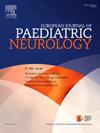Acute seizures and the risk of post-stroke epilepsy in children with arterial ischemic stroke
IF 2.3
3区 医学
Q3 CLINICAL NEUROLOGY
引用次数: 0
Abstract
Objectives
This study aims to investigate the incidence, risk factors, and long-term outcomes of acute symptomatic seizures and post-stroke epilepsy in a cohort of children and adolescents who suffered from arterial ischemic stroke (AIS-C).
Methods
Children and adolescents (aged 29 days to 16 years) with AIS-C were prospectively enrolled in the population-based Swiss Neuropediatric Stroke Registry (SNPRS) between 2000 and 2020. Demographic data, clinical presentation, and seizure characteristics were documented. Follow-up evaluations were performed at six- and 24-months post-stroke to assess the development of epilepsy. Risk factors for acute seizures and post-stroke epilepsy were analysed using univariate regression models. Of 315 patients with AIS, 201 children were male (63.5 %), with a median age of 6.1 years (IQR: 2.1–11.4). Acute seizures were observed in 75 (23.8 %) children, being the initial symptom in 44/75 (58.7 %). Status epilepticus occurred in 12/75 (16.0 %). Acute symptomatic seizures were associated with younger age (median 1.1 years [IQR 0.4–6.0] vs 7.2 years [IQR 3.8–12.2]; p < 0.001) and cortical involvement (OR 3.3; 95 % CI 1.8–6.0; p < 0.001). At the 6-month follow-up, 12 patients (4.5 %) had developed active epilepsy and 12 patients (5.4 %) at 24 months. The presence of acute symptomatic seizures did not increase the risk for epilepsy at 6 months (OR 1.5; 95 % CI 0.5 to 5.1; p = 0.47) but was associated with a higher risk at 24 months (OR 3.2; 95 % CI 1.0 to 10.7; p = 0.047). The most common stroke aetiologies, classified using the Childhood AIS Standardized Classification and Diagnostic Evaluation (CASCADE) criteria, were cardioembolic (32.0 % in patients with acute seizures vs 18.4 % in those without) and unilateral focal cerebral arteriopathy (22.7 % vs 26.4 %). Stroke aetiology remained undetermined in 20.0 % vs 31.8 %. Drug-resistant epilepsy was reported in seven children (2.2 %) with severe comorbid conditions, such as congenital heart disease and sepsis. Children with post-stroke epilepsy experienced significantly worse neurological outcomes, as measured by the Pediatric Stroke Outcome Measure (PSOM), compared to children without post-stroke epilepsy (median PSOM score 3.0 vs. 0.5, p < 0.001).
Conclusions
Acute symptomatic seizures are a common complication of paediatric ischemic stroke and are strongly associated with younger age and cortical involvement. Although these seizures do not predict early epilepsy development at 6 months, they are a risk factor for post-stroke epilepsy at 24 months. Children with post-stroke epilepsy show poorer neurological outcomes and those with severe underlying conditions are at an increased risk of drug-resistant epilepsy. These findings highlight the need for careful monitoring and early intervention in children with high-risk profiles.
动脉缺血性中风患儿急性发作及卒中后癫痫的风险
目的本研究旨在探讨儿童和青少年动脉缺血性卒中(AIS-C)急性症状性发作和卒中后癫痫的发生率、危险因素和长期结局。方法在2000年至2020年期间,前瞻性纳入以人群为基础的瑞士小儿神经卒中登记处(SNPRS)的AIS-C儿童和青少年(29天至16岁)。记录了人口统计资料、临床表现和癫痫发作特征。在中风后6个月和24个月进行随访评估,以评估癫痫的发展情况。采用单变量回归模型分析急性发作和卒中后癫痫的危险因素。315例AIS患者中,201例儿童为男性(63.5%),中位年龄6.1岁(IQR: 2.1-11.4)。75例(23.8%)患儿出现急性发作,44/75例(58.7%)患儿出现首发症状。癫痫持续状态发生率为12/75(16.0%)。急性症状性癫痫发作与年龄较小相关(中位年龄1.1岁[IQR 0.4-6.0] vs中位年龄7.2岁[IQR 3.8-12.2];p & lt;0.001)和皮层受累(OR 3.3;95% ci 1.8-6.0;p & lt;0.001)。在6个月的随访中,12名患者(4.5%)发生了活动性癫痫,24个月时,12名患者(5.4%)发生了活动性癫痫。急性症状性癫痫发作的存在不会增加6个月时癫痫的风险(OR 1.5;95% CI 0.5 ~ 5.1;p = 0.47),但与24个月时较高的风险相关(OR 3.2;95% CI 1.0 ~ 10.7;p = 0.047)。根据儿童AIS标准化分类和诊断评估(CASCADE)标准,最常见的中风病因是心栓塞(急性发作患者为32.0%,无发作患者为18.4%)和单侧局灶性脑动脉病变(22.7%,无发作患者为26.4%)。20.0%和31.8%的中风病因不明。据报道,7名儿童(2.2%)患有严重合并症,如先天性心脏病和败血症。卒中后癫痫患儿的神经系统预后明显较卒中后癫痫患儿差(PSOM评分中位数为3.0比0.5,p <;0.001)。结论急性症状性癫痫发作是儿童缺血性脑卒中的常见并发症,且与年龄和大脑皮层受累密切相关。虽然这些发作不能预测6个月大的早期癫痫发展,但它们是24个月大的中风后癫痫的危险因素。患有中风后癫痫的儿童表现出较差的神经预后,而那些有严重基础疾病的儿童出现耐药癫痫的风险增加。这些发现强调了对高危儿童进行仔细监测和早期干预的必要性。
本文章由计算机程序翻译,如有差异,请以英文原文为准。
求助全文
约1分钟内获得全文
求助全文
来源期刊
CiteScore
6.30
自引率
3.20%
发文量
115
审稿时长
81 days
期刊介绍:
The European Journal of Paediatric Neurology is the Official Journal of the European Paediatric Neurology Society, successor to the long-established European Federation of Child Neurology Societies.
Under the guidance of a prestigious International editorial board, this multi-disciplinary journal publishes exciting clinical and experimental research in this rapidly expanding field. High quality papers written by leading experts encompass all the major diseases including epilepsy, movement disorders, neuromuscular disorders, neurodegenerative disorders and intellectual disability.
Other exciting highlights include articles on brain imaging and neonatal neurology, and the publication of regularly updated tables relating to the main groups of disorders.

 求助内容:
求助内容: 应助结果提醒方式:
应助结果提醒方式:


